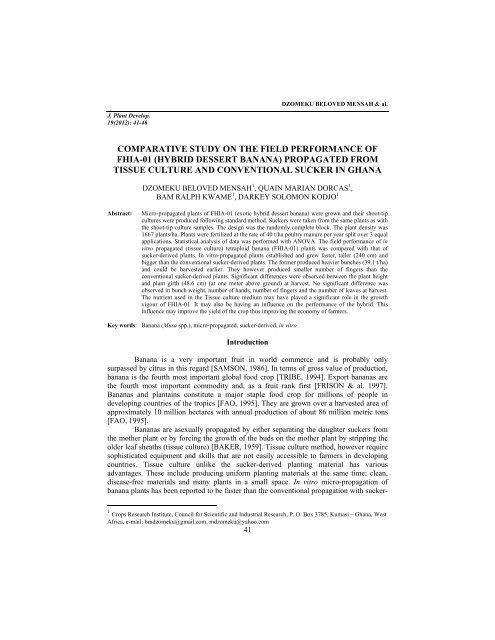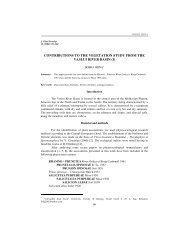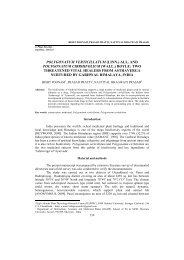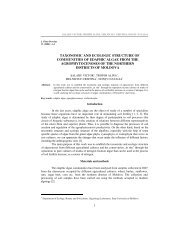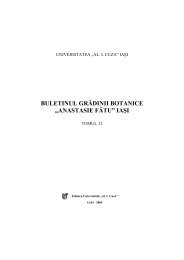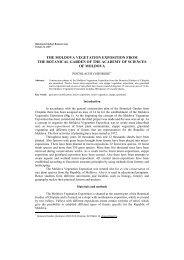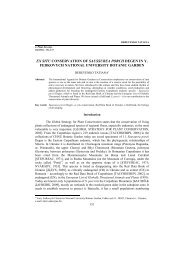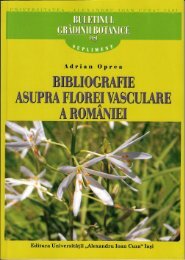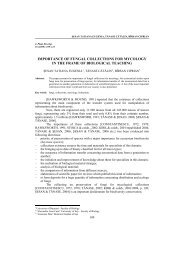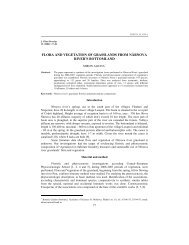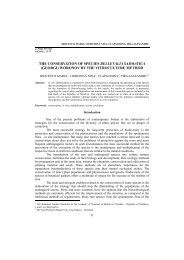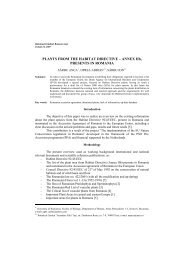comparative study on the field performance of fhia-01 (hybrid ...
comparative study on the field performance of fhia-01 (hybrid ...
comparative study on the field performance of fhia-01 (hybrid ...
You also want an ePaper? Increase the reach of your titles
YUMPU automatically turns print PDFs into web optimized ePapers that Google loves.
DZOMEKU BELOVED MENSAH & al.<br />
J. Plant Develop.<br />
19(2<strong>01</strong>2): 41-46<br />
COMPARATIVE STUDY ON THE FIELD PERFORMANCE OF<br />
FHIA-<strong>01</strong> (HYBRID DESSERT BANANA) PROPAGATED FROM<br />
TISSUE CULTURE AND CONVENTIONAL SUCKER IN GHANA<br />
DZOMEKU BELOVED MENSAH 1 , QUAIN MARIAN DORCAS 1 ,<br />
BAM RALPH KWAME 1 , DARKEY SOLOMON KODJO 1<br />
Abstract:<br />
Micro-propagated plants <strong>of</strong> FHIA-<strong>01</strong> (exotic <strong>hybrid</strong> dessert banana) were grown and <strong>the</strong>ir shoot-tip<br />
cultures were produced following standard method. Suckers were taken from <strong>the</strong> same plants as with<br />
<strong>the</strong> shoot-tip culture samples. The design was <strong>the</strong> randomly complete block. The plant density was<br />
1667 plants/ha. Plants were fertilized at <strong>the</strong> rate <strong>of</strong> 40 t/ha poultry manure per year split over 3 equal<br />
applicati<strong>on</strong>s. Statistical analysis <strong>of</strong> data was performed with ANOVA. The <strong>field</strong> <strong>performance</strong> <strong>of</strong> in<br />
vitro propagated (tissue culture) tetraploid banana (FHIA-<strong>01</strong>) plants was compared with that <strong>of</strong><br />
sucker-derived plants. In vitro-propagated plants established and grew faster, taller (240 cm) and<br />
bigger than <strong>the</strong> c<strong>on</strong>venti<strong>on</strong>al sucker-derived plants. The former produced heavier bunches (39.1 t/ha)<br />
and could be harvested earlier. They however produced smaller number <strong>of</strong> fingers than <strong>the</strong><br />
c<strong>on</strong>venti<strong>on</strong>al sucker-derived plants. Significant differences were observed between <strong>the</strong> plant height<br />
and plant girth (48.6 cm) (at <strong>on</strong>e meter above ground) at harvest. No significant difference was<br />
observed in bunch weight, number <strong>of</strong> hands, number <strong>of</strong> fingers and <strong>the</strong> number <strong>of</strong> leaves at harvest.<br />
The nutrient used in <strong>the</strong> Tissue culture medium may have played a significant role in <strong>the</strong> growth<br />
vigour <strong>of</strong> FHIA-<strong>01</strong>. It may also be having an influence <strong>on</strong> <strong>the</strong> <strong>performance</strong> <strong>of</strong> <strong>the</strong> <strong>hybrid</strong>. This<br />
influence may improve <strong>the</strong> yield <strong>of</strong> <strong>the</strong> crop thus improving <strong>the</strong> ec<strong>on</strong>omy <strong>of</strong> farmers.<br />
Key words: Banana (Musa spp.), micro-propagated, sucker-derived, in vitro<br />
Introducti<strong>on</strong><br />
Banana is a very important fruit in world commerce and is probably <strong>on</strong>ly<br />
surpassed by citrus in this regard [SAMSON, 1986]. In terms <strong>of</strong> gross value <strong>of</strong> producti<strong>on</strong>,<br />
banana is <strong>the</strong> fourth most important global food crop [TRIBE, 1994]. Export bananas are<br />
<strong>the</strong> fourth most important commodity and, as a fruit rank first [FRISON & al. 1997].<br />
Bananas and plantains c<strong>on</strong>stitute a major staple food crop for milli<strong>on</strong>s <strong>of</strong> people in<br />
developing countries <strong>of</strong> <strong>the</strong> tropics [FAO, 1995]. They are grown over a harvested area <strong>of</strong><br />
approximately 10 milli<strong>on</strong> hectares with annual producti<strong>on</strong> <strong>of</strong> about 86 milli<strong>on</strong> metric t<strong>on</strong>s<br />
[FAO, 1995].<br />
Bananas are asexually propagated by ei<strong>the</strong>r separating <strong>the</strong> daughter suckers from<br />
<strong>the</strong> mo<strong>the</strong>r plant or by forcing <strong>the</strong> growth <strong>of</strong> <strong>the</strong> buds <strong>on</strong> <strong>the</strong> mo<strong>the</strong>r plant by stripping <strong>the</strong><br />
older leaf sheaths (tissue culture) [BAKER, 1959]. Tissue culture method, however require<br />
sophisticated equipment and skills that are not easily accessible to farmers in developing<br />
countries. Tissue culture unlike <strong>the</strong> sucker-derived planting material has various<br />
advantages. These include producing uniform planting materials at <strong>the</strong> same time; clean,<br />
disease-free materials and many plants in a small space. In vitro micro-propagati<strong>on</strong> <strong>of</strong><br />
banana plants has been reported to be faster than <strong>the</strong> c<strong>on</strong>venti<strong>on</strong>al propagati<strong>on</strong> with sucker-<br />
1 Crops Research Institute, Council for Scientific and Industrial Research, P. O. Box 3785, Kumasi – Ghana, West<br />
Africa, e-mail: bmdzomeku@gmail.com, mdzomeku@yahoo.com<br />
41
COMPARATIVE STUDY ON THE FIELD PERFORMANCE OF FHIA-<strong>01</strong> (HYBRID DESSERT…<br />
derived plants [DREW & SMITH, 1990]. However, <strong>the</strong>re seems to be variety-dependency.<br />
For example, ZAMORA & al. (1989) reported that <strong>the</strong> yield from in vitro-propagated<br />
plants was significantly higher than that from sucker-derived plants in Lacatan banana<br />
(AAA), but <strong>the</strong> reverse was <strong>the</strong> case in Bungulan banana. DIRK & ORTIZ (1996) reported<br />
that in-vitro propagated Musa plants grew faster but <strong>the</strong> yield was not significantly different<br />
from that <strong>of</strong> <strong>the</strong> sucker-derived plants.<br />
FHIA-<strong>01</strong> <strong>hybrid</strong> banana is <strong>on</strong>e <strong>of</strong> <strong>the</strong> breakthroughs in Musa internati<strong>on</strong>al breeding<br />
programmes against <strong>the</strong> devastating fungal disease black sigatoka leaf spot<br />
(Mycosphaeralla fijiensis Morelet). In resp<strong>on</strong>se to <strong>the</strong>se producti<strong>on</strong> c<strong>on</strong>straints efforts<br />
aimed at <strong>the</strong> genetic improvement <strong>of</strong> Musa have made significant strides [PERSLEY & DE<br />
LANGHE, 1987]. However, germplasm enhancement is burdened with obstacles typical <strong>of</strong><br />
vegetative propagated crops, am<strong>on</strong>g which are low reproductive fertility and slow<br />
propagati<strong>on</strong> are most c<strong>on</strong>spicuous. One technique that has been identified for Musa<br />
germplasm handling and improvement is biotechnology [INIBAP, 1993]. Applicati<strong>on</strong> <strong>of</strong> in<br />
vitro culture technique has significantly improved <strong>the</strong> germplasm handling. Large numbers<br />
<strong>of</strong> in vitro plants have been produced for rapid establishment <strong>of</strong> <strong>hybrid</strong>izati<strong>on</strong> blocks and<br />
for internati<strong>on</strong>al multi-site evaluati<strong>on</strong> [VUYLSTEKE & al. 1993]. However, it has been<br />
observed that plants generated from in vitro culture exhibit various morphological and<br />
biochemical variati<strong>on</strong>s due to genetic change that LARKIN & SCOWCROFT (1981)<br />
termed somacl<strong>on</strong>al variati<strong>on</strong>. Somacl<strong>on</strong>al variati<strong>on</strong> rate <strong>of</strong> 0%-70% have been recorded in<br />
Musa produced from shoot - tip culture [SMITH, 1988; VUYLESTEKE & al. 1991].<br />
FHIA-<strong>01</strong> is <strong>hybrid</strong> banana from a cross between <strong>the</strong> wild banana and <strong>the</strong><br />
domesticated banana. It was bred against black sigatoka and nematodes. It was introduced<br />
into Ghana in early 1990 from Hunduras to be evaluated and disseminated. Sufficient<br />
evaluati<strong>on</strong> has been d<strong>on</strong>e and it has been released to farmers under <strong>the</strong> cultivar name<br />
Kwedu bempa.<br />
This <str<strong>on</strong>g>study</str<strong>on</strong>g> was carried out to compare <strong>the</strong> <strong>field</strong> <strong>performance</strong> <strong>of</strong> <strong>the</strong> <strong>hybrid</strong> using<br />
c<strong>on</strong>venti<strong>on</strong>al suckers and tissue cultured plantlets.<br />
Material and methods<br />
In-vitro derived planting materials (tissue culture) and c<strong>on</strong>venti<strong>on</strong>al suckers taken<br />
from already growing FHIA-<strong>01</strong> (Musa sp. AAA group) were chosen for <strong>the</strong> <str<strong>on</strong>g>study</str<strong>on</strong>g>. The<br />
c<strong>on</strong>venti<strong>on</strong>al suckers were produced using <strong>the</strong> split corm techniques. The trial was planted<br />
in <strong>the</strong> rainy seas<strong>on</strong> <strong>of</strong> 2008 at Fumesua near Kumasi in <strong>the</strong> semi-deciduous forest z<strong>on</strong>e <strong>of</strong><br />
Ghana. The soil was yellowish-red, moderately drained gritty clay-loam c<strong>on</strong>taining quartz<br />
gravels. The annual rainfall averaged 2400 mm from (bimodal). Plants were spaced at 3 m<br />
x 2 m, providing a density <strong>of</strong> 1667 plants/ha. Plants were established in a randomized<br />
complete block design with three replicati<strong>on</strong>s. Plants were fertilized at <strong>the</strong> rate <strong>of</strong> 40 t/ha<br />
poultry manure per year split over three equal applicati<strong>on</strong>s. Field maintenance was <strong>the</strong><br />
usual slashing with machete.<br />
Twenty plants from each plot were tagged for data collecti<strong>on</strong>. Data was taken <strong>on</strong><br />
growth parameters at two m<strong>on</strong>ths after planting and <strong>the</strong>reafter. At harvest, <strong>the</strong> following<br />
parameters were c<strong>on</strong>sidered plant height, yield, and number <strong>of</strong> leaves at harvest, number <strong>of</strong><br />
daughter suckers, plant girth at <strong>on</strong>e meter above ground, number <strong>of</strong> hands, number <strong>of</strong><br />
fingers and <strong>the</strong> crop cycle. Statistical analysis <strong>of</strong> data <strong>on</strong> growth was d<strong>on</strong>e with ANOVA.<br />
42
Results and discussi<strong>on</strong>s<br />
DZOMEKU BELOVED MENSAH & al.<br />
The results <strong>of</strong> <strong>the</strong> <str<strong>on</strong>g>study</str<strong>on</strong>g> revealed that <strong>the</strong>re was no significant difference in <strong>the</strong><br />
number <strong>of</strong> leaves both at flowering and harvest between sucker-derived and tissue culturederived<br />
plants (Tab. 1).<br />
Tab. 1. Growth characteristics <strong>of</strong> in vitro-propagated and sucker-derived banana plants<br />
under <strong>field</strong> c<strong>on</strong>diti<strong>on</strong>s<br />
Planting Materials Number <strong>of</strong> leaves at Number <strong>of</strong> leaves at No. <strong>of</strong> suckers<br />
flowering<br />
harvest<br />
Sucker- derived 13.2 7.4 4.3<br />
In vitro- Propagated 14.1 7.5 5.2<br />
P< 0.<strong>01</strong> ns ns ns<br />
ns = not significantly different n = 20<br />
The number <strong>of</strong> functi<strong>on</strong>al leaves <strong>on</strong> a banana plant at flowering plays a significant<br />
role in <strong>the</strong> yield at harvest. The higher number <strong>of</strong> leaves (about 12) is an indicati<strong>on</strong> <strong>of</strong> a<br />
heavy bunch. The high number <strong>of</strong> leaves at flowering compared favorably with <strong>the</strong> results<br />
<strong>of</strong> ALVAREZ (1997). In banana and plantain agr<strong>on</strong>omy total number <strong>of</strong> functi<strong>on</strong>al leaves<br />
that a plant has at flowering time is a good indicator <strong>of</strong> its tolerance or susceptibility to<br />
diseases, with correlati<strong>on</strong> existing between number <strong>of</strong> leaves and bunch weight.<br />
There was a significant difference in <strong>the</strong> days to flowering, fruit filling and days to<br />
harvest between sucker-derived and in-vitro-derived plants (Tab. 2). The in-vitro-derived<br />
plants flowered earlier and also matured earlier than <strong>the</strong> sucker-derived plants.<br />
Tab. 2. Yield characteristics <strong>of</strong> in vitro-propagated and sucker-derived banana plants under<br />
<strong>field</strong> c<strong>on</strong>diti<strong>on</strong>s<br />
Planting<br />
Material<br />
Days to<br />
flowering<br />
Days for<br />
fruit filling<br />
Days to<br />
harvest<br />
Bunch<br />
weight (t/ha)<br />
No. <strong>of</strong><br />
hands<br />
No. <strong>of</strong><br />
fingers<br />
Suckerderived<br />
299.5±3 98.5±1 392.3±2 38.0±1 7.4±1 107.1±2<br />
In vitro-<br />
Propagated<br />
286.2±1 90.3±4 376.5±5 39.1±2 7.5±1 104.2±3<br />
P< 0.<strong>01</strong> ** ** ** ns ns ns<br />
ns = not significantly different ** significantly different at P< 0.<strong>01</strong> n=20<br />
There was significant difference in plant height with <strong>the</strong> tissue-cultured plants<br />
producing taller plant (2.40 m) than <strong>the</strong> c<strong>on</strong>venti<strong>on</strong>al sucker (2.14 m). Fig. 1 and 2 showed<br />
that <strong>the</strong> in vitro-propagated banana plants grew faster and <strong>the</strong>ir pseudostem circumference<br />
increased faster than that <strong>of</strong> <strong>the</strong> c<strong>on</strong>venti<strong>on</strong>al sucker-derived plants. Plant height and<br />
pseudostem circumference increased more rapidly in <strong>the</strong> in vitro-propagated plants than <strong>the</strong><br />
sucker-derived plants during <strong>the</strong> vegetative growth period. Optimum growth was observed<br />
at about <strong>the</strong> sixth m<strong>on</strong>th for <strong>the</strong> in vitro-propagated plants whereas <strong>the</strong> sucker-derived<br />
occurred at 5.7 m<strong>on</strong>ths (Fig. 3). This may be a factor c<strong>on</strong>tributing to <strong>the</strong> earliness in <strong>the</strong><br />
harvest <strong>of</strong> <strong>the</strong> in vitro-propagated plants. The number <strong>of</strong> hands per bunch and <strong>the</strong> number <strong>of</strong><br />
fingers did not show any significant variati<strong>on</strong>. The in vitro-propagated plants flowered<br />
about two weeks earlier than <strong>the</strong> sucker-derived plants. This was also reflected in <strong>the</strong> days<br />
43
COMPARATIVE STUDY ON THE FIELD PERFORMANCE OF FHIA-<strong>01</strong> (HYBRID DESSERT…<br />
to harvesting as <strong>the</strong> in vitro-propagated were harvested about sixteen days earlier than <strong>the</strong><br />
sucker-derived plants.<br />
Plant height (m)<br />
3<br />
2,5<br />
2<br />
1,5<br />
1<br />
0,5<br />
in-vitro<br />
sucker-derived<br />
0<br />
2 4 6 8 10<br />
Age <strong>of</strong> FHIA-<strong>01</strong> (M<strong>on</strong>ths)<br />
Fig. 1. Plant height <strong>of</strong> in vitro-propagated and sucker-derived banana plants grown<br />
in <strong>the</strong> <strong>field</strong><br />
Pseudostem circumference (cm)<br />
60<br />
40<br />
20<br />
0<br />
grown in <strong>the</strong> <strong>field</strong><br />
2 4 6 8 10 12<br />
Age <strong>of</strong> FHIA-<strong>01</strong> (M<strong>on</strong>ths)<br />
In vitro<br />
Suckerderived<br />
Fig. 2. Pseudostem circumference <strong>of</strong> in vitro-propagated and sucker-derived<br />
banana plants grown in <strong>the</strong> <strong>field</strong><br />
44
DZOMEKU BELOVED MENSAH & al.<br />
2.5<br />
2<br />
y = -0.1x 2 + 1.14x - 0.78<br />
R 2 = 0.9948<br />
1.5<br />
1<br />
0.5<br />
y = -0.0786x 2 + 0.9414x - 0.62<br />
R 2 = 0.9843<br />
0<br />
2 4 6 8 10<br />
Age <strong>of</strong> FHIA-<strong>01</strong> (M<strong>on</strong>ths)<br />
in vitro propagated<br />
sucker-derived<br />
Poly. (in vitro propagated )<br />
Poly. (sucker-derived )<br />
Fig. 3. Relati<strong>on</strong>ship between height and age <strong>of</strong> FHIA-<strong>01</strong><br />
The yield characteristics are presented in Tab. 2. The in vitro-propagated plants<br />
grew faster that <strong>the</strong> sucker-derived plants. This was reflected in <strong>the</strong> shorter crop cycle in <strong>the</strong><br />
in vitro-propagated plants than <strong>the</strong> sucker-derived plants. The number <strong>of</strong> fingers in <strong>the</strong> in<br />
vitro-propagated plants was smaller compared to those <strong>of</strong> <strong>the</strong> sucker-derived plants yet <strong>the</strong>y<br />
weighed heavier. This may be due to <strong>the</strong> bigger finger sizes observed in <strong>the</strong> in vitropropagated<br />
plants.<br />
Several authors have reported <strong>the</strong> superior growth and yield <strong>of</strong> in vitro-propagated<br />
banana plants compared to <strong>the</strong> c<strong>on</strong>venti<strong>on</strong>al sucker-derived plants in various types <strong>of</strong><br />
bananas and plantains [DREW & SMITH, 1990; ROBINSON & al. 1993]. These results<br />
are in agreement with <strong>the</strong>ir findings. DIRK & ORTIZ (1996) however could not find any<br />
significant different in yield between tissue culture and sucker-derived banana plants. These<br />
results seemed to follow <strong>the</strong> trend observed by DIRK & ORTIZ (1996). ROBINSON &<br />
ANDERSON (1991) also reported that faster growth and high yields were not always<br />
observed in <strong>the</strong> in vitro-propagated banana. However, pseudostem circumference and<br />
height <strong>of</strong> <strong>the</strong> in vitro-propagated plants were significantly higher than those <strong>of</strong> suckerderived<br />
plants. The low yield <strong>of</strong> in vitro-propagated plants according to <strong>the</strong>se authors was<br />
attributed to high incidence <strong>of</strong> diseases.<br />
45
COMPARATIVE STUDY ON THE FIELD PERFORMANCE OF FHIA-<strong>01</strong> (HYBRID DESSERT…<br />
The faster growth <strong>of</strong> in vitro-propagated plants could be attributed to <strong>the</strong>ir intact<br />
active roots and shoot systems that can functi<strong>on</strong> almost immediately after planting. Unlike<br />
in <strong>the</strong> c<strong>on</strong>venti<strong>on</strong>al method where paring is d<strong>on</strong>e <strong>on</strong> <strong>the</strong> sucker before planting <strong>the</strong> in vitropropagated<br />
plants c<strong>on</strong>tinue to photosyn<strong>the</strong>size immediately after planting. There is<br />
<strong>the</strong>refore a lag phase in <strong>the</strong> sucker-derived plants. This lag phase may take two weeks or<br />
more for <strong>the</strong> sucker to recover. Also <strong>the</strong> in vitro-propagated plants might have some carryover<br />
nutrient stock up<strong>on</strong> which <strong>the</strong>y could depend. The factors described above could<br />
explain <strong>the</strong> differences observed between <strong>the</strong> in vitro-propagated and <strong>the</strong> sucker-derived<br />
plants.<br />
C<strong>on</strong>clusi<strong>on</strong><br />
The <str<strong>on</strong>g>study</str<strong>on</strong>g> has revealed that tissue culture applicati<strong>on</strong> in banana planting material<br />
producti<strong>on</strong> c<strong>on</strong>tributes significantly to crop <strong>performance</strong>. Tissue culture produced plantlets<br />
become robust in <strong>the</strong> <strong>field</strong>. It could be c<strong>on</strong>cluded that tissue culture produced planting<br />
materials perform agr<strong>on</strong>omically better than c<strong>on</strong>venti<strong>on</strong>ally produced materials.<br />
References<br />
1. BAKER S. 1959. Bananas in East Africa. Emp. J. Exp. Agric. 20: 66-76.<br />
2. DREW R. A. & SMITH M. K. 1990. Field evaluati<strong>on</strong> <strong>of</strong> tissue culture banana in South-Eastern Queensland.<br />
Aust. J. Exp. Agric. 30: 569-574.<br />
3. DIRK R. V. & ORTIZ R. 1996. Field <strong>performance</strong> <strong>of</strong> c<strong>on</strong>venti<strong>on</strong>al versus in vitro propagules <strong>of</strong> plantain<br />
(Musa spp.) AAB group. HortScience. 31(5): 862-865.<br />
4. FAO (Food and Agriculture Organizati<strong>on</strong> <strong>of</strong> <strong>the</strong> United Nati<strong>on</strong>s). 1995. FAO Yearbook <strong>of</strong> Agriculture.<br />
Rome. Italy.<br />
5. FRISON E. A., COLLINS W. W. & SHARROCK S. L. 1997. Global Programs: A new visi<strong>on</strong> in Agricultural<br />
Research. Issues in Agriculture. 12: 29 pp.<br />
6. INIBAP. 1993. Biotechnology applicati<strong>on</strong>s for banana and plantain improvement. Proceedings. Workshop.,<br />
San Jose, Costa Rica, 27-31 Jan.1992. Internati<strong>on</strong>al. Network for <strong>the</strong> Improvement <strong>of</strong> Banana and<br />
Plantain (INIBAP), M<strong>on</strong>tpellier, France.<br />
7. LARKIN P. J. & SCOWCROFT W. R. 1981. Somacl<strong>on</strong>al variati<strong>on</strong>-A novel source <strong>of</strong> variability from cell<br />
culture for plant improvrment. Theor. Appl. genet. 58: 197-214.<br />
8. PERSLEY G. J. & DE LANGHE E. A. (ed). 1987. Banana and plantain breeding strategies. Proc. Intl.<br />
Wkshp., Cairns, Austral., 13-17 Oct. 1986. ACIAR Proc. No. 21. Austral. Cent. Intl. Agr. Res., Canberra.<br />
9. ROBINSON J. C. & ANDERSON T. 1991. Repeat trials c<strong>on</strong>firm advantages <strong>of</strong> banana tissue culture in plant<br />
crop. Itrus Subtrop. Fruit Res. Inst. Inf. Bull. 288: 10-11.<br />
10. ROBINSON J. C., CONNIE F. & ECKSTEIN K. 1993. A <strong>field</strong> comparis<strong>on</strong> <strong>of</strong> c<strong>on</strong>venti<strong>on</strong>al suckers with<br />
tissue culture planting over three crop cycles. J. Hort. Sci. 68: 831-836.<br />
11. SAMSON J. A. 1986. Tropical Fruits. Sec<strong>on</strong>d editi<strong>on</strong>. L<strong>on</strong>gman, New York.<br />
12. TRIBE D. 1994. Feeding and Greening <strong>the</strong> World: The Role <strong>of</strong> Internati<strong>on</strong>al Agricultural Research. Ox<strong>on</strong>,<br />
United Kingdom: CAB Internati<strong>on</strong>al.<br />
13. VUYLSTEKE D., SWENNEN R. & DE LANGHE E. 1991. Somacl<strong>on</strong>al variati<strong>on</strong> in plantains (Musa spp.,<br />
AAB group) derived from shoot-tip culture. Fruits. 46: 429-439.<br />
14. VUYLSTEKE D., SWENNEN R. & ORTIZ R. 1993. Development and <strong>performance</strong> <strong>of</strong> black sigatokaresistant<br />
tetraploid <strong>hybrid</strong>s <strong>of</strong> plantain (Musa spp., ABB group). Euphytica. 65: 33-42.<br />
15. SMITH M.K. 1988. A review <strong>of</strong> factors influencing <strong>the</strong> genetic stability <strong>of</strong> micro-propagated bananas. Fruits.<br />
43: 219-223.<br />
16. ZAMORA A. B., DAMASCO O. P., ESTANO E. S., BARBA R. C. & PATENA L. F. 1989. Growth and<br />
yield <strong>of</strong> in vitro and sucker-derived banana plants (Musa spp.) cvs. Lakatan, Bungulan and Saba.<br />
Philippine Agriculturist. 72: 458-465.<br />
46


